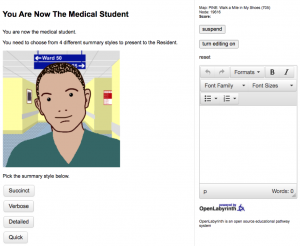OLab and Virtual Roles
Authors: David Topps, Michelle Cullen, Corey Wirun
[Full report is available at https://www.researchgate.net/publication/351060255_OLab_and_Virtual_Roles ]
In virtual scenario learning designs, we are accustomed to the concepts of Time-shifting, and place-shifting. In time-shifting, we can use virtual time (moving the case forwards at a different pace, jumping ahead seconds to years, as compared with high-fidelity mannequin scenarios where the emphasis tends to be on real-time responses), or we can time-shift the experience with learners asynchronously tackling scenarios or cases according to the personal needs.
In place-shifting, we can change the context of the scenarios from the challenges of wilderness or roadside, to emergency room bay or the back of the ambulance, each with their own risks and resources. Or we can place-shift the learner and teacher, with remote interaction, unhindered by geography. This is commonplace.
In our various projects and case series, we have also experimented with the less common variation of person-shifting. Contrary to most external resources that we have examined, where the participant is usually confined to a single role, steadily working their way through a linear case presentation, we have explored many different approaches to changing the virtual role of the participant.
One of the simpler but more effective narrative devices to employ in your case designs is that of virtual roles. Normally, in virtual patient cases, you are expected to assume a single role, usually that of a caregiver. With the current emphasis on patient-centred care, what better way to convey the perspective than to put the player in the role of the patient/client or family member?
This has been particularly effective in inter-professional education (IPE), where appreciation of the scope of practice, skills and challenges faced by other members of a multidisciplinary team has been central in the key learning points in our projects.
In one of our earliest cases, written in 2007 for the Pathways in Narrative Education (PINE) project, based on OLab v2, we had ‘Walk a Mile in my shoes”, in which the learner was variously placed in the role of parent, medical student, nurse practitioner, resident, and family doctor. [1]

Although the clinical content, which revolved around a simple case of ankle injury, was quite basic, the case highlighted some of the differences in communication styles between different disciplines.
In our Health Services Virtual Organization (HSVO) case series,[2] where we used quite a sophisticated combination of camera arrays, virtual scenarios, virtual anatomy segmentations, and high-fidelity mannequins, all connected by user-directed light-pipes, we were able to explore some complex learning designs with teams of learners from four organizations, across two continents.
From the learners’ perspective, some of key learning revolved around a greater appreciation for the diverse skillsets exhibited by paramedics, nursing and medical students. While all the teams were working on the same complex virtual scenario, each team took it in turn to lead the next phase of the patient extraction from a remote trauma site. The scenario required collaboration on many levels between and within the teams to achieve a successful completion.
Virtual patients and scenarios can also be employed for non-medical uses e.g about leadership competencies.[3] Or as one college demonstrated, virtual scenarios can be completely unrelated to patient care and focused instead on technical support roles in computer science, where the role of the player can be that of customer, tech support agent or supervisor.
We have also made extensive use of virtual learners and teachers in our faculty development projects. Our community-based faculty are occasionally stressed by learners in difficulty. The effects can be far reaching. We have developed a series of virtual learners on which they can try their skills at precepting some quite difficult challenges.[4] This has also produced some interesting insights into the failure-to-fail phenomenon,[5,6] and demonstrated that the traditional reasons given for such failure do not always apply.
Simulation fidelity
How realistic does a scenario need to be to be effective? The Computerized Training industry has lots of examples of such simulations, some of which look quick slick. E.g. https://www.syandus.com/sales-training/see-virtual-role-play-scenario
There is much emphasis on role-playing in such computer-based training, along with an emphasis on making the actions of the avatars realistic and engaging. Indeed, on first appearance, these singing-dancing avatars are much more impressive than the plain text and static images that predominate our own virtual scenario learning designs.
In our HSVO and later projects,[7,8] we accumulated an extensive amount of Second Life experience – we found that our participants spent a LOT of time refining their avatars, creating some truly dramatic and creative personas. But this does not have much effect on the game play or case interaction. Once the novelty of flying and building islands had worn off, the learning outcomes were no different from simpler narrative-focused virtual scenarios.
Over two decades of experimentation with such learning designs, we have found that appearances can be deceiving. What really influences learning and behaviour change is to present the participants with challenging situations and decisions with real consequences that reflect the actual dilemmas that they face in practice. Despite the technical sophistication of e-learning platforms, all too many case designs focus on fact regurgitation and memorization.
Natural Language Communications
One of the key challenges facing the authors of virtual scenarios is how to present learners with choices and yet not give the game away with pre-defined cues. Now for most decision points in a virtual scenario, it is perfectly reasonable to present the learners with a simple set of choices. Indeed, this can be made more effective, when all the choices are reasonable rather than the traditional quiz-style single-best-answer approach. The learners then have to deal with the consequences of their choices.
But for some decision points, it is desirable to avoid such cues and allow for natural language input. This allows learners to formulate their own answers when the nuances of language may change the intended outcome.[9] Indeed, there is a whole segment of gaming which revolves around Interactive Fiction engines and their ability to handle such inputs. While these are very capable tools, most teaching faculty do not have the time or resources to create such scenarios, or to debug the multiple ways in which a participant’s response can be encoded.
Our Turk Talk approach, described elsewhere,[10,11] has proven to be a flexible solution to the vagaries of simple natural-language processing. Using a simple chat-based interface, Turk Talk allows the facilitator to interact with up to eight learners concurrently. While we were initially hesitant that a text-based interaction would be seen as realistic, we have instead found that learners often prefer this communication mode and instead appreciate good learning designs and realistic problems to solve.
With the pandemic-driven move towards virtual and online interactions, our virtual scenarios and TTalk now provide groups with a variety of tools with which to educate and assess the skills of their learners and teams. The place-shifting mentioned above now becomes crucial in this time of quarantines and isolation, compared with on-site live role-playing games.
We have been particularly appreciative of the axiological benefits of these tools and the TTalk approach. We have accelerated our scenario design process, been able to reduce or relocate facilitator manpower and reuse existing case designs.
We have even found economies, both in scale, and in time required to train and resource our teaching staff. Contrary to the findings of Shirazi et al,[12] we have not found it difficult or time-consuming to create scripts for our facilitators. We do agree with Talwakar [13] that a team-based approach to script writing is beneficial: it helps when considering that the clinical content is accurate; that the psychosocial details are realistic; that the objectives are relevant to the curriculum; and that appropriate cues are provided.
We do not agree with Talwakar that it is either desirable or feasible to know your actors. We find that most facilitators can easily assimilate the script, which does not convey the expected dialogue verbatim but simply portrays the essential points to be discussed. This approach ensures that course objectives are being met, while allowing for variability in the responses which contributes to the realism of the interaction. We also do not agree that it takes time to train your actors, unless this is a high-stake examination. In the same manner as we have conducted our OSCE training sessions with standardized patients over many years, it is usually sufficient to provide the script with time allowed for a quick run-through. The facilitator script does not need to be lengthy or detailed, as shown in this example.[14]
What needs to be in the script?
- Learning objectives and learner level
- Context: describe relevant details such as location, available resources and personnel
- Role to be played by the actor
- Personal characteristics, communication style
- Info to be divulged or hidden
- Key prompts and time points
- Dress/costume/appearance is not needed as this is virtual.
- Macros and boilerplate text that can be quickly inserted for repetitious phrases
In comparison with OSCEs, we have found TTalk to have much greater cost effectiveness.[15] Partly, this is due to the scalability of the approach, allowing many learners to concurrently interact with the facilitator; to the virtualization and place-shifting; and to the reduced time in scenario authoring, with little need for programming or debugging.
As noted in the introductory paragraphs of this report, we have also found that TTalk and our virtual scenarios align well with the concept of virtual roles and role-switching. This is much easier than with live role-play.
Future directions
We have explored the use of chatbots but have not been impressed with their utility or time-cost up to now. This will improve but, despite the assertions of Hubal,[16] who claims that this is easy to do but provides no data re time or costs, we have yet to cross the point of good axiology. We note that natural language processing can be made quite sophisticated, e.g. the Maryland Virtual Patient project,[17] but find that few faculties have millions of dollars that they can spend on a single scenario.
In future projects, there are a number of aspects of person- or role-shifting that we plan to explore. The new version of the OLab platform[18] has been developed with team-based learning in mind. Unlike most tools that assess team-based performance, OLab4 can evaluate the contributions of individual team-members, rather than just the performance of the team as a whole.
What about role-flipping? Have the learner and facilitator flip roles back and forth repeatedly e.g. in a customer support exercise.
Tag-team wrestling – there is an established model where a new participant can tag in when they want to assume the role of learner in the live role-playing game… but most participants are too shy to do this and will instead lurk. In OLab4, we can assign them to the new role on the fly.
Theoretically, we could even do this in groups in a virtual approach to Hockey Lines[19] — but how would the team on the bench keep up with what is happening on the rink? This is easier in live-action. Are there certain cues that make for an essential transfer of function? How little information is enough? Info transfer at shift-change time is a prime source of medical error so this would present an especially rich research opportunity.

